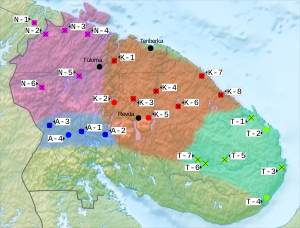
Back Skoltsamische Sprache ALS Sami skolt AST Skuolta samiu kalba BAT-SMG Скольцкая саамская мова BE-X-OLD Сколт-саамски език Bulgarian Samieg Skolt Breton Sami skolt Catalan Колтта-саамийн мотт CE Skoltská sámština Czech Sameg Sgolt Welsh
This article's factual accuracy may be compromised due to out-of-date information. The reason given is: In addition to inaccuracy, another issue is that the palatalization marker is wrong in many places in this article. (September 2019) |
| Skolt Sámi | |
|---|---|
| nuõrttsääʹmǩiõll | |
| Pronunciation | [nuɘrʰtːɕa̟ːmʰʲc͡çiɘlː] |
| Native to | Finland, Russia |
| Ethnicity | Skolts |
Native speakers | c. 330 (2002-2023) |
| Dialects | Northern:
Southern:
|
| Latin | |
| Language codes | |
| ISO 639-2 | sms |
| ISO 639-3 | sms |
| Glottolog | skol1241 |
| ELP | Skolt Saami |
| Glottopedia | Skolt_Saami[1] |
 Skolt Sámi language area (red) within Sápmi (grey) | |
 Skolt Sámi is classified as Severely Endangered by the UNESCO Atlas of the World's Languages in Danger (2010) | |
Skolt Sámi (sääʹmǩiõll, pronounced [ɕa̟ːmʰʲc͡çiɘlː], lit. 'the Sámi language'; or nuõrttsääʹmǩiõll, pronounced [nuɘrʰtːɕa̟ːmʰʲc͡çiɘlː], lit. 'the Eastern Sámi language') is a Sámi language that is spoken by the Skolts, with approximately 300[2] speakers in Finland, mainly in Sevettijärvi and approximately 20–30 speakers of the Njuõʹttjäuʹrr (Notozero) dialect[3] in an area surrounding Lake Notozero in Russia. In Norway, there are fewer than 15 that can speak Skolt Sámi (as of 2023);[4] furthermore, the language is[4] largely spoken in the Neiden area.[3] It is written using a modified Roman orthography which was made official in 1973.
The term Skolt was coined by representatives of the majority culture and has negative connotation which can be compared to the term Lapp. Nevertheless, it is used in cultural and linguistic studies.[5] In 2024, Venke Törmänen, the leader of an NGO called Norrõs Skoltesamene, wrote in Ságat, a Sámi newspaper, saying that the term "Eastern Sámi" ("østsame" in Norwegian) should not be used to refer to the Skolt Sámi.[6]

- ^ Glottopedia article on Skolt Sami.
- ^ K.H. "Språket bare en person snakker" [The language that only one person speaks]. 29 December 2020. Klassekampen. P. 29 "knapt 300 igjen som kan, som [...] Veikku Feodoroff fortalte til Klassekampen tidligere i år" [barely 300 left that can, as [...] Veikku Feodoroff told Klassekampen earlier this year]
- ^ a b Sergejeva 2002, p. 107.
- ^ a b Ole Magnus Rapp. 2023-11-06. Klassekampen. P.24
- ^ Sergejeva 2002, p. 103.
- ^ https://www.sagat.no/nyheter/skoltesame-og-ikke-ostsame/19.45476. Sagat.no. Retrieved 2024-11-11